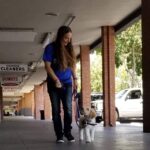When a recent career changed dog returned permanently to our home, we knew immediately that she was a top candidate for therapy work.
Cotton is an awesome little lady…
A medium size yellow Labrador retriever, career changed from guide dog training due to her “tender” paw pads which made it impossible for her to work as a guide for the blind. To work as a guide she would have been required to work along the streets and sidewalks that become very hot in the summer months. Her paw pads could not handle that heat. Cotton did very well in her training and passed all the tests for guide work but after many months of attempts to heal her paw pads unsuccessfully, the decision was made to career change her. For Cotton, that meant a return home.
There was no doubt that therapy work was going to be Cotton’s work of choice.
She certainly possessed the aptitude and demeanor for such a life. Calm and well behaved, obedient, happy, willing to work, with an abundant love for people, describes Cotton to perfection. I knew, without question that Cotton would bring big smiles and much happiness to all she met. Other service type work was out of the question for her since any other work would require her to spend considerable time out of doors in what would be at times, harsh conditions for her feet.
After weeks of searching the internet for local therapy organizations that Cotton could attend for training and testing, we found the perfect match and we proceeded to make contact with what is now known as Alliance of Therapy Dogs. I learned that there were several volunteers registered with these organizations that were approved to certify a dog for therapy work. I made contact and our first appointment was arranged after Cotton had been home for at least 3 months. We had to drive 100 miles to start this process, but this was an important step for Cotton and I together and it was worth the drive. I could not deny sharing Cotton’s gifts of love and friendliness with others through her new job. She was a natural.
Cotton and I attended several evaluations/testing’s that included gatherings of other therapy dogs, also under consideration for registry. Her behavior around the other dogs was one point of the evaluation. Cotton was also evaluated around young children, older folks, people in wheelchairs, walkers, with crutches and more. She learned quickly and was evaluated for her behavior in hospital rooms and greeting people in all these circumstances. She was also tested for her obedience and ability to control her behavior as needed.
Other requirements for a therapy dog include an annual health exam, up to date on necessary vaccinations, including rabies, cleanliness and regular grooming.
Required equipment includes an adequate collar that fits snugly so the dog cannot back out of the collar easily and an adequate leash that is 4 feet or shorter. No retractable, elastic/bungee type, or chain leashes are allowed. Unapproved collars would be: pinch, prong, spiked or electronic. Body harnesses with secure fasteners are acceptable as are head collars. There is no size restriction for a dog.
Upon Cotton’s successful completion of her evaluation, the results were turned into the Alliance of Therapy Dogs. There was no cost for her evaluation and testing but we had a couple of registration fees (minimal) to send in with her test results and then we received our official I.D. card with scarf and tag identifying Cotton as officially registered as a therapy dog. She only wears her tag and scarf when we are visiting a host location. Through her official registration we have insurance coverage for unexpected situations when making official visits.
Now she was official and it was time to find a host location to match Cotton with for some fun therapy visits.
As a therapy dog Cotton cannot go into public places like a guide dog or other service/assistance dog. Therapy dogs are still pet dogs and must follow the “NO Pets Allowed” rules. Cotton goes to locations where she is specifically invited by a facility that has invited her and agreed to host her. In that situation she is allowed into the building. A service/assistance dog is legally allowed (Americans with Disabilities Act) access to all public places, but again, not a “therapy” dog.
As her handler, I am the only person allowed to handle Cotton in therapy work. We were required to go through all evaluations and test as a “pair”, together.
Cotton is now beginning her second year of this special work, and she loves it.
She just seems “to know” when it’s our day to go for therapy visits. Her excitement at home is almost uncontrollable as she becomes a jumping jack and spin top all in one. She knows immediately when I gather her little therapy scarf and tag, collect a few clean up kits, water bowl, extra leash and a toy or two, that we are “going out” for a visit. I pack them all up in a little bag I carry with us. Once we arrive at our therapy location, she understands she must now be on her best behavior, and she is perfect. After unloading the items to bring in with us, I take her, on leash, over to an area in the parking lot and ask her to relieve. It’s wonderful that she has learned how to relieve on command. That’s a great helps in avoiding any accidents once we go inside for her therapy visits.
We have visited retirement and nursing homes, schools, libraries, and currently we are making regular visits to a local Autism Center. We normally keep our visits to an hour or two at the longest. It’s a job (a fun job) to Cotton and she is always very alert and dedicated to being on task to provide a loving experience to those she meets on her visit. By the end of our visit, she is ready for some down time and sleeps soundly on our drive home. She is always ready for her next visit, be it the next day or the next week.
At home Cotton is a well behaved and a typical fun-loving Labrador.
She has her moments of mischief though. After all, she is still a dog. She and her pal Pat spend many hours in gentle loving play as well as moments of “high energy” play regulated to the back yard. They are both very obedient and learned best house manners as young pups, so their large size in the house is of no concern to the two-legged family members.
I encourage anyone with a healthy dog of any breed that has matured and shows calm behavior, with good obedience and a love of visiting people, to look into getting your dog certified for therapy work. There are many locations that would welcome you and your dog for a visit.
Happy visits, out & about, to all our therapy buddies.
Alice & “Cotton”







